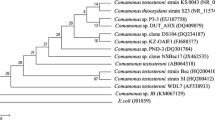Abstract
A mixed culture, enriched from Sphagnum peat moss, contaminated with gasoline vapours, degraded individual and mixed components of BTEX (benzene, toluene, ethylbenzene, xylene). Complete degradation of radiolabelled toluene by the mixed culture was observed in mineralisation studies. Individual isolates from a mixed culture containingPseudomonas maltophilia, P. testosteroni andP. putida biotype A exhibited contrasting BTEX degradation patterns. WhileP. putida biotype A degraded all of the BTEX compounds,P. maltophilia andP. testosteroni, appeared unable to degrade benzene and xylenes, respectively. When the peat, inoculated with the mixed culture, was used as a biofilter (6.2 cm diameter ×93 cm length) for degradation of toluene and ethylbenzene vapours, percentage removal efficiencies were 99 and 85, respectively. When the capacity of the biofilter to degrade a combination of BTEX compounds was evaluated, percentage removal efficiencies for toluene, ethylbenzene,p-xylene,o-xylene and benzene were 99, 85, 82, 80 and 78, respectively. The importance of using the mixed culture as an inoculum in the biofilter was established and also the relationship between contaminated vapour flow rate and percentage removal efficiency.
Similar content being viewed by others
References
Alvarez PJJ and TM Vogel. 1991. Substrate interactions of benzene, toluene, andp-xylene during microbial degradation by pure culture and mixed culture aquifer slurries. Appl Environ Microbiol 57(10): 2981–2985.
Bel'kevich PI, LR Chistova, LM Rogach and VS Pekhtereva. 1983. Determination of the sorption capacity of peat with respect to petroleum products. Vestsi Akad Navuk BSSR Ser Khim Navuk 3: 79–83.
Bhatnagar L and BZ Fathepure. 1991. Mixed cultures in detoxification of hazardous waste. In: Mixed Cultures in Biotechnology (Zeikus JG and EA Johnson, eds), pp 293–340, McGraw Hill, New York.
Cohen AD, MS Rollins, WM Zunic and JR Durig. 1991. Effects of chemical and physical differences in peats on their ability to extract hydrocarbons from water. Wat Res 25(9): 1047–1060.
D'Hennezel F and B Coupal. 1972. Peat moss: a natural absorbent for oil spills. Can Mining Met Bull (CIM) 65: 51–53.
Eitner D. 1990. Biofilter in der Praxis. In: Biologische Ablufreinigung, p 55, Expert Verlag, Ehningen.
Glaze WH, CC Lin, JL Burleson, JE Henderson, D Mapel, R Rawley and DR Scott. 1983. Optimization of liquid-liquid extraction methods for analysis of organic in water. Project Report, Contract Nos CR-805472 and CR-808561, USEPA/EMSL, Cincinnati, Ohio.
Hodge DS, VF Medina, RL Islander and JS Devinny. 1991. Treatment of hydrocarbon fuel vapours in biofilter. Environ Technol 12: 655–662.
Leson G and AM Winer. 1991. Biofiltration: an innovative air pollution control technology for VOC emissions. J Air Waste Mgmt Assoc 41: 1045–1054.
Lochhead AG and RH Thexton. 1947. Growth and survival of bacteria in peat, II. Peat pellets. Can J Res 25: 14–19.
Lochhead AG and RH Thexton. 1947. Growth and survival of bacteria in peat, I. Powdered peat and related products. Can J Res 25: 1–13.
Martin AM. 1992. Biofilms in peat biofilters. In: Biofilms—Science and Technology (Melo LF, TR Bott, M Fletcher and B Capdeville, eds), pp 461–466, Kluwer Academic Publishers. Dordrecht, The Netherlands.
Moores WD. 1983. Oil spill absorbing peat. Eur Pat Appl EP 75 384 (Cl C09K3/32).
Ottengraff SPP, A Van den Oever and FJCM Kempenaars. 1984. Waste gas purification in a biological filter bed. In: Innovations in Biotechnology (Houwink EH and R, van der Meer, eds), pp 157–167, Elsevier Science, Amsterdam.
Ottengraff SPP, JJP Meesters, AHC van den Oever and HR Rozema. 1986. Biological elimination of volatile xenobiotic compounds in biofilters. Bioproc Engin 1: 61–69.
Patrick GC, CJ Ptacek, RW Gillham, JF Barker, JA Cherry, D Major and CI Mayfield. 1985. The behaviour of soluble petroleum product derived hydrocarbons in groundwater. In: Phase I report No. 85-3, Petroleum Association for Conversion of the Canadian Environment, p 69, Ottwa, Canada.
Peters DA, GT Hickman, JG Stefanoff and MB Garcia Jr. 1993. Laboratory assessment of biofiltration for fuel-derived VOC emissions control. In: Proceedings of the 86th Annual Symposium for Air and Waste Management, Denver, Colorado.
Technische Anleitung Luft. 1986. Technical Instructions on Air Quality Control: First General Administrative Regulation pertaining to the Federal Emission Control Law: Bundesanzeiger Verlagsgellschaft, Köln.
Whealty RE, MO Greaves and RHE Inkson. 1976. The aerobic bacterial flora of a raised bog. Soil Biol Biochem. 8: 453–460.
Yavorsky J. 1993. Biofiltration for control of gas streams containing low concentrations of volatile organic compounds. In: Proceedings of the 86th Annual Symposium for Air and Waste Management, Denver, Colorado.
Zhang L, M Hirai and M Shoda. 1991. Removal characteristics of dimethyl sulfide, methanethiol and hydrogen sulfide byHyphomicrobium sp 155 isolated from peat moss. J Ferment Bioeng 72(5): 392–396.
Zilli M, A Converti, A Lodi, MD Borghi and G Ferraiolo. 1993. Phenol removal from waste gases with a biological filter byPseudomonas putida. Biotechnol Bioeng 41: 693–699.
Author information
Authors and Affiliations
Rights and permissions
About this article
Cite this article
Mallakin, A., Ward, O.P. Degradation of BTEX compounds in liquid media and in peat biofilters. Journal of Industrial Microbiology 16, 309–318 (1996). https://doi.org/10.1007/BF01570040
Received:
Accepted:
Issue Date:
DOI: https://doi.org/10.1007/BF01570040




